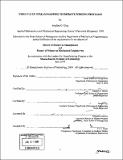Using value stream mapping to improve forging processes
Author(s)
King, Stephen G. (Stephen George), 1974-
DownloadFull printable version (9.800Mb)
Other Contributors
Leaders for Manufacturing Program.
Advisor
Stephen C. Graves and Daniel Frey.
Terms of use
Metadata
Show full item recordAbstract
Value stream mapping is a technique that uses icons to map the flow of product through a manufacturing system. These icons are aided by summary statistics to further detail the specific manufacturing system. The value stream mapping process usually consists of defining the current state of the system and then, using the principles of lean manufacturing, mapping an improved future system state. Although this is the popular technique, variants and refinements of it exist. This work examines the various techniques of value stream mapping and the methods used to evaluate value stream maps to improve manufacturing systems. The past and current research into value stream mapping and the methods to analyze these maps are compared and contrasted. A set of core analysis questions is developed that summarize the various value stream mapping methodologies. The application of these questions to an enhanced value stream map is developed as a tool, hybrid value stream mapping. Hybrid value stream mapping is then used to analyze the current state value stream map of a manufacturing process, the forging of automotive ring gears. The answers to the core analysis questions enabled the identification of weaknesses in the manufacture of ring gears and suggested system-wide problems. To further clarify and suggest means to rectify these weaknesses, methods beyond the scope of value stream mapping were utilized. By using systems based on standard inventory theory, economic production quantities, techniques to improve information visibility, and methods to enhance production equipment savings of over $4.7 million net present value were discovered for the ring gear production process.
Description
Thesis (M.B.A.)--Massachusetts Institute of Technology, Sloan School of Management; and, (S.M.)--Massachusetts Institute of Technology, Dept. of Mechanical Engineering; in conjunction with the Leaders for Manufacturing Program at MIT, 2004. Includes bibliographical references (p. 79-81).
Date issued
2004Department
Leaders for Manufacturing Program at MIT; Massachusetts Institute of Technology. Department of Mechanical Engineering; Sloan School of ManagementPublisher
Massachusetts Institute of Technology
Keywords
Sloan School of Management., Mechanical Engineering., Leaders for Manufacturing Program.